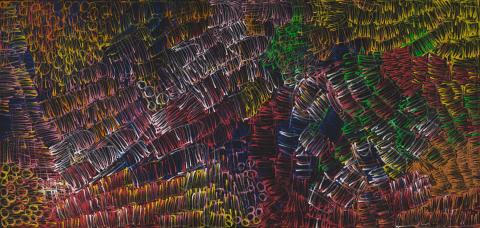ESSAY: 2003.162 PWERLE
By Holly Arden
September 2003
Minnie Pwerle was born around 1910 in the Utopia region of the Western Desert which is located approximately 270 km north east of Alice Springs. Her country is called Atnwengerrp and her languages are Anmatyerre and Alyawarr.
The Utopia artists' community has flourished since the introduction of contemporary media in the form of batik workshops, introduced in 1977. In 1994 Utopia women artists travelled to Java, Indonesia, to take part in batik workshops. In 1998 Rodney Gooch, then working for CAAMA (Central Australian Aboriginal Media Association), introduced canvas and acrylic paints.1
Amongst the artists at Utopia a number emerged with important and enduring individual visions and capacities for expression. The most significant have been the great Emily Kame Kngwarreye (c.1910–96) (who is Pwerle's sister-in-law), Kathleen Petyarre, Gloria Petyarre and Pwerle's daughter, Barbara Weir, who had been taken away from her family at a young age.
Pwerle began painting on canvas in 1999, after taking part in workshops conducted by her grandson, Fred Torres, at the Dacou Aboriginal Gallery in Adelaide. Aged in her late eighties, Pwerle's output has been prolific. Pwerle's painting style resonates with the bold, expressive brushwork that characterised the work of Kngwarreye.
Pwerle has exhibited at a range of national and international venues since 2000. Prior to working on canvas, her principal artistic expression was through the application of body paint to participants in women's ceremonies. Her creation stories concern the bush melon, bush melon seed and Awelye Atwengerrp, which literally means 'women's ceremony from the Atnwengerrp' (a region near the Sandover River north of Utopia).2 The bush melon is found only in Atnwengerrp and is becoming increasingly rare. In this important painting the pattern represents the designs painted on women's upper bodies during Atnwengerrp ceremonies, which celebrate bush food.3
By depicting the fruit, Pwerle reflects her love of and respect for the land.4 Vibrant, dynamic brushstrokes sweep across the canvas. The vivid colours commonly used by Utopia artists were described by Victoria King after a recent visit to this region:
Like Emily, all the women of Utopia love vibrant colour and use it fearlessly and with great effect in their paintings.... When hunting with the women, you suddenly become aware of flashes of fluorescent emerald as ring-neck parrots dart overhead, and the bright pinks, lime greens, saffron yellows, purples and carmines of flowers and berries are more prevalent and astonishing against the red sand than one could imagine.5
Awelye Atwengerrp is a beautiful example of the continuing legacy of Kngwarreye and an indication of the unique visual styles of Utopia's women artists.
Essay by Holly Arden, former Curatorial Assistant, Contemporary Australian Art, September 2003.
Endnotes
- 'Artist's biography: Gloria Petyarre', viewed 27 Apr. 2004, < http://www.mahoneysgalleries.com.au/artist_biography.cfm?id=45>.
- Jenny Green (Institute for Aboriginal Development, Alice Springs), Telephone conversation with Holly Arden, 11 Sept. 2003.
- Fred Torres (Director, Dreaming Art Centre of Utopia), Telephone conversation with Holly Arden, 15 Sept. 2003.
- 'Artist biography: Minnie Pwerle', viewed 4 July 2003, <http://www.alisonkellygallery.com/artistsrep-bio-minnie-pwerle.htm>.
- Victoria King, 'Utopia now: A journey to Emily's country', Art and Australia, vol. 37, no. 4, 2000, p.525.
Connected objects
Metadata, copyright and sharing information
About this story
- Subject
